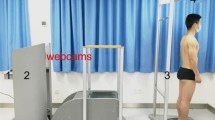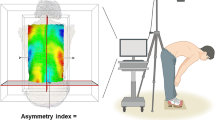Abstract
This work reviews the non-invasive scoliosis assessment methods for adolescents in recent years.The purpose of this study was to investigate the non-radiological assessment methods for the treatment of scoliosis that have been studied so far, the tools, characteristics, and validity, and to discuss their advantages and disadvantages. A total of 32 literature articles were compiled on non-radiological assessment methods for scoliosis, including camera measurements, 3D body scans, Kinect-based computer vision-based postural analysis system method, and gait analysis based on cursor camera and inertial sensors.
Access this chapter
Tax calculation will be finalised at checkout
Purchases are for personal use only
Similar content being viewed by others
References
Liu, T., Wang, Y., Yang, Y., et al.: A multi-scale keypoint estimation network with self-supervision for spinal curvature assessment of idiopathic scoliosis from the imperfect dataset. Artif. Intell. Med. 125, 102235 (2022)
Sabri, N., Hamed, H.N.A., Ibrahim, Z., et al.: 2D Photogrammetry image of scoliosis lenke type classification using deep learning. In: 2019 IEEE 9th International Conference on System Engineering and Technology (ICSET). IEEE, pp. 437–440 (2019)
Moreira, R., et al.: A computer vision-based mobile tool for assessing human posture: a validation study. Computer Methods and Programs in Biomedicine 214, 106565 (2022)
Yellakuor, B.E., Moses, A.A., Zhen, Q., Olaosebikan, O.E., Qin, Z.: A multi-spiking neural network learning model for data classification. IEEE Access 8, 72360–72371 (2020)
Amin, A., Abbas, M., Salam, A.A.: Automatic detection and classification of scoliosis from spine X-rays using transfer learning. In: 2022 2nd International Conference on Digital Futures and Transformative Technologies (ICoDT2), pp. 1–6. IEEE (2022)
Aroeira, R.M.C., Estevam, B., Pertence, A.E.M., et al.: Non-invasive methods of computer vision in the posture evaluation of adolescent idiopathic scoliosis. J. Bodyw. Mov. Ther. 20(4), 832–843 (2016)
Penha, P.J., Penha, N.L.J., De Carvalho, B.K.G., et al.: Posture alignment of adolescent idiopathic scoliosis: photogrammetry in scoliosis school screening. J. Manipulative Physiol. Ther. 40(6), 441–451 (2017)
Saad, K.R., Colombo, A.S., Ribeiro, A.P., et al.: Reliability of photogrammetry in the evaluation of the postural aspects of individuals with structural scoliosis. J. Bodyw. Mov. Ther. 16(2), 210–216 (2012)
Navarro, I.J.R.L., da Rosa, B.N., Candotti, C.T.: Anatomical reference marks, evaluation parameters and reproducibility of surface topography for evaluating the adolescent idiopathic scoliosis: a systematic review with meta-analysis. Gait Posture 69, 112–120 (2019)
Bortone, I., et al.: Recognition and severity rating of parkinson’s disease from postural and kinematic features during gait analysis with microsoft Kinect. In: International Conference on Intelligent Computing, pp. 613–618. Springer (2018)
Journal of King Saud University-Computer and Information Sciences 34(10), 8899–8908 (2022)
Aroeira, R.M.C., Leal, J.S., de Melo Pertence, A.E.: New method of scoliosis assessment: preliminary results using computerized photogrammetry. Spine 36(19), 1584–1591 (September 01, 2011). https://doi.org/10.1097/BRS.0b013e3181f7cfaa. Sabri, N., Hamed, H.N.A., Ibrahim, Z., et al.: The hybrid feature extraction method for classification of adolescence idiopathic scoliosis using Evolving Spiking Neural Network[J]
Aroeira, R.M.C., et al.: Método não ionizante de rastreamento da escoliose idiopática do adolescente em escolares. Ciência & Saúde Coletiva [online] 24(2), 523–534 (2019). Acessado 3 Janeiro 2023
Kim, D.-J., et al.: Review study on the measurement tools of scoliosis: mainly on non-radiological methods. Journal of Korean Medicine. The Society of Korean Medicine (2021). https://doi.org/10.13048/jkm.21006
Rothstock, S., Weiss, H.R., Krueger, D., et al.: Clinical classification of scoliosis patients using machine learning and markerless 3D surface trunk data. Med. Biol. Eng. Compu. 58(12), 2953–2962 (2020)
Choi, Y.C.C.L., Kwon, K.R.: Standardization study of thermal imaging using the acupoints in human body. Journal of pharmacopuncture 11(3), 113–22 (2008)
Lubkowska, A., Gajewska, E.: Temperature distribution of selected body surfaces in scoliosis based on static infrared thermography. Int. J. Environ. Res. Public Health 17, 8913 (2020)
Vutan, A.-M., et al.: Evaluation of symmetrical exercises in scoliosis by using thermal scanning. Appl. Sci. 12, 721 (2022)
Haddas, R., Ju, K.L., Belanger, T., et al.: The use of gait analysis in the assessment of patients afflicted with spinal disorders. Eur. Spine J. 27, 1712–1723 (2018)
Zhang, J., Li, H., Yu, B.: Correlation between cobb angle and spinous process angle measured from ultrasound data. In: Proceedings of the 2017 4th International Conference on Biomedical and Bioinformatics Engineering (2017)
Menger, R.P., Sin, A.H.: Adolescent and idiopathic scoliosis. StatPearls. Treasure Island (FL) 2020
Kim, D.S., Park, S.H., Goh, T.S., et al.: A meta-analysis of gait in adolescent idiopathic scoliosis. J. Clin. Neurosci. 81, 196–200 (2020)
Sohn, M.J., Kim, K.H.: Conformity assessment of a computer vision-based clinical decision support system for the detection of postural spinal deformity (2022)
Furlanetto, T.S., Candotti, C.T., Comerlato, T., et al.: Validating a postural evaluation method developed using a Digital Image-based Postural Assessment (DIPA) software. Comput. Methods Programs Biomed. 108(1), 203–212 (2012)
Bortone, I., et al.: Gait analysis and parkinson’s disease: recent trends on main applications in healthcare. In: International Conference on NeuroRehabilitation, pp. 1121–1125. Springer (2018)
Bortone, I., et al.: A novel approach in combination of 3d gait analysis data for aiding clinical decision-making in patients with parkinson’s disease. In: International Conference on Intelligent Computing, pp. 504–514. Springer (2017)
Pesenti, S., et al.: Characterization of trunk motion in adolescents with right thoracic idiopathic scoliosis. Eur. Spine J. 28(9), 2025–2033 (2019)
Bortone, I., Piazzolla, A., Buongiorno, D., et al.: Influence of clinical features of the spine on Gait Analysis in adolescent with idiopathic scoliosis. In: 2020 IEEE International Symposium on Medical Measurements and Applications (MeMeA), pp. 1–6. IEEE (2020)
Kainz, H., et al.: Reliability of four models for clinical gait analysis. Gait Posture 54, 325–331 (2017)
Boompelli, S.A., Bhattacharya, S.: Design of a telemetric gait analysis insole and 1-D convolutional neural network to track postoperative fracture rehabilitation, LifeTech 2021 – 2021 IEEE 3rd Glob. Conf. Life Sci. Technol. pp. 484–488 (Mar. 2021)
Cabral, S., Resende, R.A., Clansey, A.C., Deluzio, K.J., Selbie, W.S., Veloso, A.P.: A global gait asymmetry index. J. Appl. Biomech. 32(2), 171–177 (2016)
Cho, J., Cho, Y.S., Moon, S.B., et al.: Scoliosis screening through a machine learning based gait analysis test. Int. J. Precis. Eng. Manuf. 19(12), 1861–1872 (2018)
Author information
Authors and Affiliations
Corresponding author
Editor information
Editors and Affiliations
Rights and permissions
Copyright information
© 2024 ICST Institute for Computer Sciences, Social Informatics and Telecommunications Engineering
About this paper
Cite this paper
Cheng, F., Lu, L., Sun, M., Wang, X., Wang, Y. (2024). Non-invasive Scoliosis Assessment in Adolescents. In: Wang, B., Hu, Z., Jiang, X., Zhang, YD. (eds) Multimedia Technology and Enhanced Learning. ICMTEL 2023. Lecture Notes of the Institute for Computer Sciences, Social Informatics and Telecommunications Engineering, vol 535. Springer, Cham. https://doi.org/10.1007/978-3-031-50580-5_18
Download citation
DOI: https://doi.org/10.1007/978-3-031-50580-5_18
Published:
Publisher Name: Springer, Cham
Print ISBN: 978-3-031-50579-9
Online ISBN: 978-3-031-50580-5
eBook Packages: Computer ScienceComputer Science (R0)




